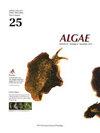Fissipedicella orientalis gen. et sp. 11 (Ralfsiales, Phaeophyceae):一种新的朝鲜褐藻
IF 2.4
3区 生物学
Q1 MARINE & FRESHWATER BIOLOGY
引用次数: 0
摘要
褐藻科褐藻包括四属:褐藻属、褐藻属、褐藻属和褐藻属。本文从分子和形态两个方面对东方裂虱进行了详细的描述。我们对rbcL和连接数据集(rbcL + 5 '区域细胞色素c氧化酶亚基I [COI-5P])的系统发育分析表明,在韩国收集的标本嵌套在具有鲁棒bootstrap支持和贝叶斯后验概率的Ralfsiaceae中一个独特的新分支中。东方花rbcL和COI-5P的序列差异分别为7.4-10.1和17.5-21.2%。裂蒂草的特征是:壳状菌体具有下菌体基底层和直立的菌体周丝,在凹陷中有毛丛,每个细胞有一个叶绿体,多子体有1-3个不育细胞,茎上有1-6个垂直或斜裂的细胞。我们认为,尽管东方菊是一种,但它可以被认为是一种新的属级分类单元。我们的新属裂蹄草与裂蹄草科的其他成员的区别在于其体的类型、叶绿体的数量和坑中毛簇的数量,以及花序的发育。本文章由计算机程序翻译,如有差异,请以英文原文为准。
Fissipedicella orientalis gen. et sp. nov. (Ralfsiales, Phaeophyceae), a new crustose brown alga from Korea based on molecular and morphological analyses
The crustose brown algal family Ralfsiaceae comprises four genera: Analipus, Endoplura, Heteroralfsia, and Ralfsia. This study provides a detailed description of Fissipedicella orientalis gen. et sp. nov. based on molecular and morphological analyses. Our phylogenetic analyses from rbcL and concatenated dataset (rbcL + 5′ region of cytochrome c oxidase subunit I [COI-5P]) reveal that specimens collected in Korea are nested in a distinct new clade within Ralfsiaceae with robust bootstrap support and Bayesian posterior probabilities. The sequence divergences for rbcL and COI-5P between F. orientalis and other genera within Ralfsiaceae are 7.4–10.1 and 17.5–21.2%, respectively. Fissipedicella orientalis is characterized by crustose thalli with a hypothallial basal layer and erect perithallial filaments, tufts of hairs in pits, a single chloroplast per cell, plurangia with 1–3 sterile cells, and unangia on stalks composed of 1–6 vertically or obliquely cleaved cells. We propose that F. orientalis can be recognized as a new genus-level taxon within Ralfsiaceae, even though a single species represents it. Our new genus, Fissipedicella, is distinguished from the other members within the Ralfsiaceae by the type of thallus, the number of chloroplasts and tufts of hairs in pits, and the development of unangia.
求助全文
通过发布文献求助,成功后即可免费获取论文全文。
去求助
来源期刊

Algae
PLANT SCIENCES-
CiteScore
5.10
自引率
25.00%
发文量
18
期刊介绍:
ALGAE is published by the Korean Society of Phycology and provides prompt publication of original works on phycology. ALGAE publishes articles on all aspects of phylogenetics and taxonomy, ecology and population biology, physiology and biochemistry, cell and molecular biology, and biotechnology and applied phycology. Checklists or equivalent manu-scripts may be considered for publication only if they contribute original information on taxonomy (e.g., new combinations), ecology or biogeography of more than just local relevance. Contributions may take the form of Original Research Articles, Research Notes, Review Articles and Book Reviews.
 求助内容:
求助内容: 应助结果提醒方式:
应助结果提醒方式:


